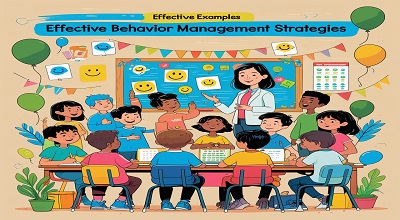Behavior Management in Classrooms
Behavior management in classrooms refers to the strategies and techniques teachers use to create a structured, positive, and productive learning environment. It involves preventing disruptive behaviors, reinforcing positive actions, and addressing challenges effectively.
With evolving educational demands, behavior management has shifted from punitive measures to more proactive and supportive approaches. Modern classrooms emphasize social-emotional learning (SEL), trauma-informed practices, and student-centered discipline.
Importance of Behavior Management in Classrooms
Effective behavior management is crucial because:
- Enhances Learning: A well-managed classroom minimizes disruptions, allowing students to focus.
- Promotes Safety: Clear rules reduce conflicts and bullying.
- Builds Social Skills: Students learn responsibility, respect, and self-regulation.
- Reduces Teacher Stress: Predictable structures help educators manage classrooms efficiently.
Theories Behind Behavior Management
Several psychological theories guide behavior management:
A. Behaviorism (Skinner, Pavlov)
- Focuses on reinforcement (rewards) and punishment.
- Example: A student receives a sticker for completing homework.
B. Social Learning Theory (Bandura)
- Students learn behaviors by observing others.
- Example: Peer modeling for positive behavior.
C. Cognitive Behavioral Theory (Beck, Ellis)
- Links thoughts, feelings, and behaviors.
- Example: Teaching students to reframe negative thoughts.
D. Humanistic Approach (Maslow, Rogers)
- Emphasizes empathy and student autonomy.
- Example: Restorative justice circles for conflict resolution.
Effective Behavior Management Strategies
A. Positive Reinforcement
Rewarding desired behaviors increases their recurrence.
- Example: A points system where students earn privileges.
B. Clear Expectations and Rules
Explicitly stating rules helps students understand boundaries.
- Example: Posting classroom rules with visual aids.
C. Consistent Consequences
Fair and predictable responses to misbehavior maintain order.
- Example: A warning → time-out → parent contact.
D. Building Relationships
Strong teacher-student connections reduce defiance.
- Example: Morning check-ins to discuss emotions.
E. Proactive vs. Reactive Approaches
Preventing misbehavior is better than reacting to it.
- Example: Seating plans to minimize distractions.
Examples of Behavior Management Techniques
A. Elementary Classroom Examples
- Token Economy: Students earn tokens for good behavior, redeemable for prizes.
- Quiet Critters: Plush toys sit on desks of quiet students as positive reinforcement.
B. Middle School Classroom Examples
- Behavior Contracts: Agreements outlining expectations and rewards.
- Peer Mediation: Students help resolve minor conflicts.
C. High School Classroom Examples
- Self-Monitoring Charts: Students track their own behavior.
- Restorative Practices: Group discussions to repair harm.
Technology and Behavior Management
- ClassDojo: Tracks behaviors with real-time feedback.
- Google Classroom: Sets digital behavior goals.
- Apps like “Too Noisy”: Monitors classroom noise levels.
Challenges in Behavior Management
- Diverse Needs: ADHD, autism, and trauma require tailored approaches.
- Parental Involvement: Lack of support from home can hinder progress.
- Teacher Burnout: Managing extreme behaviors can be exhausting.
Latest Trends in Classroom Behavior Management
- Trauma-Informed Teaching: Understanding students’ backgrounds.
- Mindfulness Practices: Reducing stress and improving focus.
- Gamification: Using game elements to motivate behavior.
FAQs
Q1: What is the most effective behavior management strategy?
A: Positive reinforcement combined with clear expectations works best.
Q2: How can I handle extreme behaviors like aggression?
A: Stay calm, ensure safety, and follow school protocols (e.g., behavior intervention plans).
Q3: Should punishments be used in behavior management?
A: Consequences should be logical and restorative rather than purely punitive.
Q4: How can technology help in behavior management?
A: Apps like ClassDojo provide instant feedback and engagement tracking.
Q5: What role do parents play in behavior management?
A: Consistent home-school communication reinforces expectations.
Conclusion
Behavior management is a dynamic aspect of teaching that requires adaptability, empathy, and structured strategies. By integrating evidence-based techniques, teachers can foster a positive classroom climate that supports both academic and social growth.
Free Link: SuperStar SMTOWN APK
